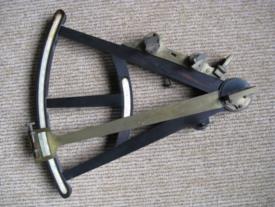
NavList:
A Community Devoted to the Preservation and Practice of Celestial Navigation and Other Methods of Traditional Wayfinding
From: Brendan Kinch
Date: 2014 Oct 13, 21:00 +0200
Hi John,
First we can have a look at the name Mefser. That is old English for Messer and quite likely this octant was made by Benjamin Messer (1729-1827) and as such will be an older octant than that previously enquired about on this site. I say this because of the construction - it would fall in with Benjamin Messer dates. Is there any chance that ‘JOH NYMAN’ as you have quoted is BENJAMAN or similar. (Sometimes the spelling on old instruments – even names – leaves one wondering).
John Crichton (mentioned yesterday) was an apprentice of Benjamin Messer.
As for the lower mirror – this was for back sights. The slot in the middle was for viewing the back horizon……I’ll have a look see if I can find a diagram to better explain. (Or perhaps someone else has one handy?)
Kinch.
From: NavList@fer3.com [mailto:NavList@fer3.com] On Behalf Of John Karl
Sent: 13 October 2014 20:16
To: BrenKinch@gmail.com
Subject: [NavList] Re: C. 1830 Octant
Bill & All,
Those are two good looking octants. The one in the attached pic is not in quite as good shape. But can anyone comment on this octant. On the frame's cross arm it says "JOH NYMAN" and on the left end of the arc it says "Mefser" above the scale, and "London" below the scale. The letter "s" in "Mefser" is not very clear, and neither is the "r."
The mirror below the horizon mirror is mirrored on both sides with a clear vertical slot down the center. Whay this for? And what is the open slot in the frame between these two mirrors for??
JK
Attached File: 
(Octant-2.jpg: Open and save)






